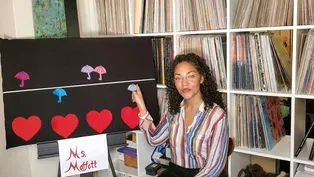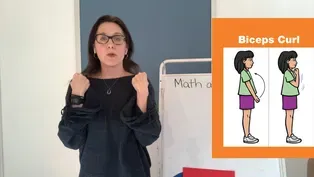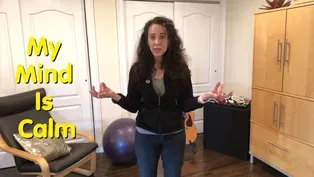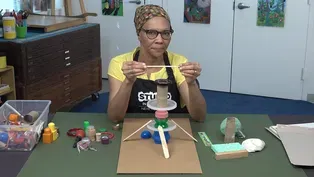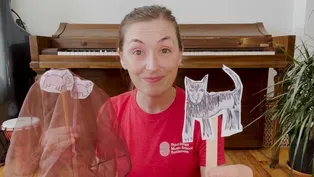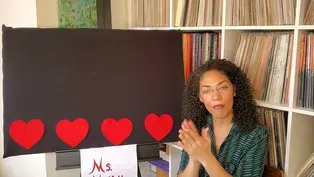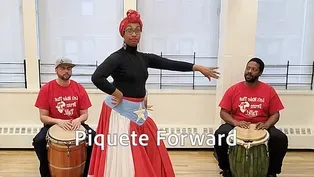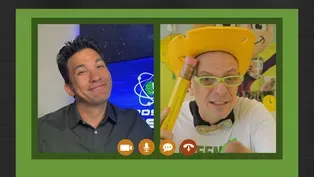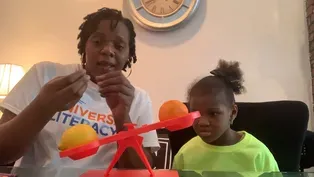
Super and Power Both End in “er”!
5/18/2021 | 57m 45sVideo has Closed Captions
Learn about number 7, power poses, and Spanish greetings, read SUPER SATYA SAVES THE DAY.
Learn about the number 7, power poses, and Spanish greetings, dance the hands, read SUPER SATYA SAVES THE DAY, practice two-syllable r-controlled vowels. LET’S LEARN helps children ages 3-8 with at-home learning. One-hour programs feature instruction by educators and virtual field trips.
Problems with Closed Captions? Closed Captioning Feedback
Problems with Closed Captions? Closed Captioning Feedback
Let's Learn is a local public television program presented by THIRTEEN PBS

Super and Power Both End in “er”!
5/18/2021 | 57m 45sVideo has Closed Captions
Learn about the number 7, power poses, and Spanish greetings, dance the hands, read SUPER SATYA SAVES THE DAY, practice two-syllable r-controlled vowels. LET’S LEARN helps children ages 3-8 with at-home learning. One-hour programs feature instruction by educators and virtual field trips.
Problems with Closed Captions? Closed Captioning Feedback
How to Watch Let's Learn
Let's Learn is available to stream on pbs.org and the free PBS App, available on iPhone, Apple TV, Android TV, Android smartphones, Amazon Fire TV, Amazon Fire Tablet, Roku, Samsung Smart TV, and Vizio.
Providing Support for PBS.org
Learn Moreabout PBS online sponsorshipMore from This Collection
Video has Closed Captions
Read SCHOOL BUS and draw one, learn about prefixes and pitch, build sculptures. (57m 48s)
Running and Counting Both End in “ing”!
Video has Closed Captions
Move to improve, find the missing number, learn songs from Ghana, read ABUELITA’S SECRET. (58m 17s)
What Sound Does “aw” Make in Draw?
Video has Closed Captions
Read a story, discover "au" and "aw," learn about density, count, and move with music. (56m 58s)
Can You Find the Short “u” in Subtract?
Video has Closed Captions
Help Super Grover 2.0 solve a prickly problem, read ALL THE WAYS TO BE SMART. (56m 19s)
What Sound Does “gl” Make in Glove?
Video has Closed Captions
Play the glockenspiel, help Super Grover 2.0 make a cart move, read TWO WOOL GLOVES. (58m 9s)
Incredible Starts with Short “i”!
Video has Closed Captions
Solve problems with Super Grover 2.0, catch a rainbow, hear a piano sound like a cuckoo. (56m 9s)
What’s the Sound of “oo” in Book?
Video has Closed Captions
Explore animals’ form and function, sing about the 3 little pigs, read THE LITTLE BOX. (58m 15s)
We’re Reducing, Reusing and Recycling!
Video has Closed Captions
Learn all about rhythm and the number 9, read A BAG IN THE WIND. (56m 17s)
Video has Closed Captions
Learn to dance bomba and grow food in a city, read WOLF CUB’S SONG. (55m 20s)
How Many Syllables are in Invent?
Video has Closed Captions
Invent your own instrument, make 10 to add numbers to 20, read ONE GOLDEN RULE AT SCHOOL. (57m 36s)
Video has Closed Captions
Learn about the science behind mind reading, count shells, read MY BIG FAMILY. (57m 27s)
Which is Heavier: One Apple or Two Apples?
Video has Closed Captions
Defy gravity, learn secret code words for fast and slow in music, read WHOOO KNEW? (58m 5s)
Providing Support for PBS.org
Learn Moreabout PBS online sponsorship[cheerful music] - [Announcer] Ready to learn?
- Hi!
- Hi!
- [Announcer] It's time to share a story.
- Shhh!
- Read and write.
- Let's read it back.
- [Announcer] Discover science, sing.
♪ Somewhere ♪ - [Announcer] Play, and so much more.
- Cupcake!
- Very good!
- [Announcer] Stay tuned for lessons and activities.
- We're gonna start making some words.
Isn't that fun?
[cheerful music] - [Announcer] Funding for this program was provided by the JPB Foundation.
- Hi friends, welcome to story time, with me, Miss Darlene.
Today's read aloud is called "Super Satya Saves the Day," a story by Raakhee Mirchandani, and pictures by Tim Palin.
In today's read aloud, we'll hear about a young girl, who learns some super valuable lessons about her super powers, and stick around after the video, I'll show you how you can make your very own superhero pencil puppet.
So if you're ready, let's have fun reading!
Hey!
Squeak, squeak, squeak!
Honk!
Honk!
Beep!
Beep!
It was a loud day, on a loud street, in the very loud town of Hoboken.
The fire trucks may fire truck noises, the police cars made police car noises, and the swings at church square park, were extra squeaky, and the knot in Super Satya's stomach felt super tight.
How was she supposed to do all of the things that superheroes do if her superhero cape was stuck at the dry cleaner?
Oh no!
Satya wish they could've picked the cape up on the way to school, but the dry cleaner was closed.
Super Mama said she was super late to work, and they couldn't wait for the store to open.
They did stop for coffee, though.
They always stopped for coffee.
Mama says, if she doesn't have any coffee, her head would explode!
"Today is going be the worst!"
Superstar Satya thought as they headed to school.
All of her superhero powers were in the cape that Super Mama made for her, and there was just no way for super senses were going to work without it.
Let's stop here for a moment and think.
Hmm.
Usually superheroes carry something with them that makes them super.
And for Satya it's her cape, and it's stuck at the dry cleaner.
I wonder what she's feeling.
How do you think she feels?
That's right, she might be super worried, or nervous about her day.
Let's keep reading to see how it goes.
At school, Ms. Karina was teaching the class about communities.
Satya was excited to build her own city, but she couldn't get the structures quite right.
She knew it was because she always did her best thinking with her cape on her back.
Satya slumped in her chair.
Nothing was going right today!
That's when she spotted Tanya, her friend Jehan's lost T-Rex!
Tonya had been missing for days, and Jehan had been so super sad.
Super Satya scooped Tanya up and ran over the Jehan, who hugged his pal Satya so tight, she felt some Super Breath leave her belly.
"Super Satya, you did it!
You found her!
You really are a hero!"
Jehan said.
"Not without a cape," Satya thought, as a class headed out for an afternoon walk.
Tweet!
Tweet!
Bloot!
Bloot!
Toot!
Toot!
Chirp!
Chirp!
Outside, the boats were making boat noises, and the birds were making bird noises.
It was very loud!
Suddenly, Super Satya heard a sound that didn't belong.
It was a gentle whimper coming from somewhere near the grass.
As she got closer, the noise got louder.
A scared set of puppy eyes peeked out from behind the trashcan.
"Don't worry, little friend, we'll find your family," Super Satya whispered.
He does look super scared!
Tweet!
Tweet!
Bloot!
Bloot!
"Leo!"
Chirp!
Chirp!
In the distance, a boy was holding a leash, running and shouting, "Leo, Leo, come here, buddy!"
He looked just as scared as the dog!
"I think he's over here," Super Satya called to the boy.
"He looks really scared, and I heard him crying."
She heard him crying over all the noise, of the boats, and traffic, and the birds.
Wow, she's got some really super senses.
"His collar is too big for him," said the boy.
"Thank you for finding him.
I love him so much and I was really worried.
You must have some super hearing, to I've heard his little cry with all the noise out here!"
Super Satya walked a little straighter on the way back to school.
Her super eyes and ears seemed to work just fine without the cape!
After school, Satya was missing her cape more than ever!
Today was a day she planned to conquer the tallest slide in Hoboken, but there was no way that was happening without her trusty cape.
Forget it!
But then, Super Satya started thinking about the day.
She thought about all the super things she had done, and all the friends that she had helped.
Remember Jehan, and his lost T-Rex?
And a little boy at park who lost his dog?
Satya helped them with all of that.
And now she's reflecting, which means that she's thinking back on her day.
Hmmm.
"Hmmm, I wonder.
Do I really need my cape?"
Do you think Super Satya really needs the cape?
Look at all of the wonderful things she was able to do today.
Do you think she'll conquer that slide after all?
Let's keep reading.
With a quick nod, and a wink to her Super Dada, Super Satya ran up the steps, and took her spot at the top of the slide.
She was so scared!
But she was also super excited!
Wow, look at how big the slide is!
Super Dada seems so far away!
Without thinking about anything else.
she let go.
"You did it!"
Super Dada exclaimed, as he picked her up and gave her a kiss.
"You are super brave!"
Wow!
Super Satya used some of her senses today, even though she didn't have her cape, and those senses were super, right?
She was able to spot her friend's lost T-Rex, and she was able to use her super sense of hearing to hear that little puppy who was scared when he was lost in the park.
And, most of all, every superhero needs a dose of courage, and she did have that courage when she was so brave, and got up at the top of that slide.
And look how happy she is now.
On the way home, Super Dada and Super Satya stopped at the dry cleaner, just like Super Mama said they would.
The cape was pressed and ready.
"Thanks to Mrs. Markowitz!
You'll always take such good care of my cape," Satya said, as they left the shop.
Having her kid back sure felt great, Satya thought as she draped it over her shoulders, but she knew her day was super because she was Super Satya!
I hope you enjoyed today's read aloud.
I love this story because it reminds me that we all have a little bit of superhero inside of us, even on days when we're not feeling our best, just like Satya.
Think back on times of the day that maybe you did do something that a superhero would do.
Did you try your very best?
Did you try something new?
Or did you help someone in need?
Then you are a superhero!
Stick around, I'll show you how you can make your very own superhero pencil puppet.
For this activity, you will need some colored paper, or white drawing paper.
Remember, if you don't have colored paper at home that is okay, you can always use your crayons, pencils or markers to color the white paper any color you would like.
You're also going to need a pencil for your pencil puppet, a pair of scissors, that you'll ask a trusted adult to help you to cut with, and some tape to put it all together.
The first thing you're going to do, is you're going to use your pencil to draw some basic shapes.
Now you're gonna draw a circle, that you'll use for your face.
And you're going to draw a medium-sized triangle, and the triangle shape you're going to use for your superhero cape.
Make sure the triangle is not too large, because it's gonna fit right, maybe, towards the top of your pencil.
Okay?
So you're going to need a small circle, and a medium-sized triangle.
If you'd like to add some hair to your superhero, you're going to cut any type of shape you'd like to add here, and it will go right on top of your circle, and you can color it in any color you'd like, okay?
Next up, we're gonna decorate our superhero.
Every superhero should have a really cool name.
If I were a superhero, I think my name would be Super D!
[giggling] So I'm gonna add my name to my cape first, and I'm gonna leave some space in the middle for my symbol, because every superhero has their own symbol, too.
Super D. Now I'm going to add my symbol.
I think my symbol would be a purple heart, because the heart's gonna remind me to spread love with everything that I do, and I think my superhero power would be to spread love.
I wonder what your superpowers will be?
Next I'm going to add some features to the circle that I'm going to use for my face.
Now, for my superhero, I really want a nice, pink mask to match my cape.
A little over your eyes, I wanna color that in.
I decided to add some big, black curls for my superhero's hair.
So your final step is you're going to turn over all of your shapes, on the opposite side, and you're gonna tape them all together.
After you've taped all of your pieces together, you're now gonna tape it to your pencil.
Make sure you leave enough room for your hands at the bottom, so that whenever you use this pencil, it won't be in the way.
And now, I just tape it together.
And there you have a superhero pencil puppet!
I'm Super D!
[laughing] I had so much fun with this activity.
Now, every time I use this pencil, it will remind me of the superhero inside of me, and I hope yours reminds you of a superhero inside of you.
Remember to be kind, try your best and to help others when you can.
And, as always, keep reading!
- Hi movers and shakers, this is Violet, and I'm really excited to get to sing a song today with my friend.
- Thank you, Violet, for inviting me to meet with you and your friends.
My name is Jeremy Watson, and I am a music teacher at P.S.
21 Staten Island, home the Eagles.
Violet asked me to share a song with you today, because of everything that's going on in the world.
With kids suddenly having to learn from home, or even others making each other feel bad because of how different we look for one another.
It's important to remember that we are not alone, that we're in this together, and that we are a part of one race, the human race.
So when things look dim, look for the light that shines inside, and let your light shine for the whole world to see.
This song is called "This Little Light of Mine."
It's a call and response song, which means I'll sing a phrase, the call, and you'll sing back, the response.
Are you ready?
Let's go.
♪ This little light of mine ♪ ♪ I'm gonna let it shine ♪ ♪ Oh this little light of mine ♪ ♪ I'm gonna let it shine ♪ ♪ This little light of mine ♪ ♪ I'm gonna let it shine ♪ ♪ Let it shine, let it shine, let it shine ♪ ♪ This little light of mine ♪ Your turn!
♪ ♪ I'm gonna let it shine ♪ ♪ Oh, this little of mine ♪ ♪ I'm gonna let it shine ♪ ♪ Oh, this little light of mine ♪ ♪ I'm gonna let it shine ♪ ♪ Let it shine ♪ ♪ Let it shine ♪ ♪ Let it shine ♪ - Thanks, Jeremy.
I always love singing with you.
Thanks everyone!
[cheerful music] - Hi everyone, welcome back.
My name is Miss Nicole, and today we are going to be working on two-syllable words.
The work that we're going to do is, we are going to blend and segment two-syllable words.
We're going to talk about their vowel, consonant, consonant, vowel patterns.
We're going to learn how to break words into syllables, and we're going to be able to read words that have two syllables with the R-controlled vowels.
We have a lot of work to do today, but I'm really excited to do it with you, and I hope you're ready.
All right, so the first part, all we have to do is listen.
We're going to listen to hear how many syllables are in each word.
I'll do the first one, listen.
The word is corner.
Say the word, corner.
Good.
Now, when I listen to the parts, there's two parts to that word, cor, ner, corner.
Very good.
All right, are you ready to try one with me?
Okay, here's your first one.
Listen to the word, repeat it, and tell me how many beats or syllables, you hear in the word.
Ready?
Okay.
The word is turkey.
How many syllables are in the word turkey?
Tur, key.
Two!
Great job, okay, next one.
The word is, remember.
Remember.
Nice work, re, mem, ber.
Remember.
Okay, here we go.
Barber.
Two.
Bar, ber, barber.
Okay, curl.
Curl your hair.
Curl.
One, curl.
Okay.
How about butterfly?
Yep!
But-ter-fly.
But-ter-fly.
Three syllables.
Okay, last one.
Urgent.
Urgent.
Urgent means that it is really important, and needs to be attended to immediately.
It's urgent.
How many syllables?
Two!
Ur-gent.
Great job.
Okay, now we're going to review our R-controlled vowels.
What are the vowels, do you remember?
Of course!
A, E, I, O, and U.
Now, when we see those vowels next to the consonant R, the R kind of takes over the sound of the vowel, and it makes that R-controlled sound.
Okay, like we have in A-R, farm.
A-R, arrr, farm.
So I'm gonna write A-R over here, because that is one R-controlled vowel that we'll be working with today.
Another one is, I-R, like the word girl.
I-R, errr, girl.
Okay.
Then we also have E-R, errr, for her.
E-R, errr.
Good!
And then there is, U-R, errr, like curl.
U-R, errr.
And then finally, we have O-R, like organ.
And O-R-E, which is seen at the end of a word, like more.
O-R-E, orrr.
All right, so those are our R-controlled vowels.
Okay, for this part, we are going to be building some two-syllable R-controlled vowel words together!
As you can see, I have my cards, up here for my letters, that we usually use.
Okay, has the pink ones for the vowels, and the ivory colored ones are our consonants, but I had to make some special cards here today for our R-controlled vowels that we've been practicing.
So this one, just to review, E-R, errr, I-R, errr, U-R, errr, right?
When we see those together in a word, we know to make that sound, so be on the lookout for it.
Okay, so the first word we're going to build together is the word burger.
Say burger.
Bur-ger.
You can almost hear where the syllable break is, right?
Okay.
So now let's look at the two parts.
Oops, let me bring it in for you to see.
There we go, perfect.
Okay.
So this part is the first syllable.
Notice, here's the vowel, U.
And here's the other vowel, E. Good, now find where the two consonants are, and divide the word.
See, that's where I broke it.
Good, now we say the first part bah, err, berrr.
Good, cover up that and say the second part.
Ga, errr, gerrr.
Good, let's now push it together.
Berr, gerrr.
Burger!
Excellent!
All right, let's do another one.
This time, the word is perfect.
All right, here we go.
The second word.
Perfect.
Notice where we break it.
Find the vowels.
There are two of them.
Here's one.
The R-controlled E vowel, and the other vowel by itself, no R. Find the two consonants in between the vowels, and that's where we break the word.
This is the first syllable.
This is the second syllable.
Make sure over here you blend the two final consonants.
Okay?
Here we are.
Pah, errr.
Perr.
Fff, eh, ct. Fect.
Per-fect.
Perfect.
Great work.
All right.
And the last word that we're going to build together is the word 30.
Say 30.
Good, like the number.
All right, for this one, we only see one vowel in pink.
Do you remember the other letter that sometimes we recognize as a vowel at the end of a word?
Yes, the letter Y, good.
So for the word 30, where would you break this word up?
Where would you split it?
Well, if this is the first vowel, and the Y is acting as the other vowel, here are the two consonants.
We split it here, and we say thhh, errr, therrr, tee.
Tee.
Thir-ty.
30.
So let's look at this word that I wrote on my board.
The word is turnip.
Mmm, I love turnips.
Turnips are a root vegetable that we usually have around harvest time, November for Thanksgiving.
But today we're going to look at the word a little bit differently, not as a food, but as a two-syllable word.
And the way that we can identify that is by counting how many vowels we see.
So, I see one vowel here, the vowel U, So I'm going to put the V underneath it, to represent the vowel.
Then I see there's another vowel over here, and that's the vowel I.
So when I see the two vowels, it tells me that it's going to be a two-syllable word.
Now, in order to figure out where the syllables splits, I have the consonant R, and the other consonant, N. And when I see the two consonants, I know that it gets split right down the middle.
So, now I can look at the first syllable, is the consonant T, the vowel U and R. Remember that U-R errr sound, like in curl.
Good.
So put the consonant first, and blend those sounds with me.
Ttt, errr, terrr.
Good, now we're going to do the second part of the word.
And the second part we do the same way, just cover up the first syllable.
And then we see the consonant, vowel, consonant, and blend those sounds.
Nnn, ihh, Nip.
Nip, good.
And now we can blend the whole word together.
Terr-nip, turnip.
Great work.
All right, so.
I'm going to write another word, and I want you to see if you could tell me where the vowels are first.
Okay?
Okay?
Here's the first vowel.
E. And here's the other vowel.
E. See the two consonants?
Good.
Know where to split it?
Okay, you try it.
Say the first part.
Perrr.
Good.
Perrr.
And then the second part.
Fff, ehhh, ct. Fect.
Good, this one has a blend also at the end.
Okay, remember, the blends, the consonants keep their sounds, they just blend closer together.
Fect.
Perr, fect.
Perfect.
You're doing great!
All right, let's try another one.
Notice where the vowels are.
Find the consonants.
Split them.
Blend the first syllable.
The second syllable.
And then put them together.
Great work, I hope you noticed the R-controlled vowel at the end in the word butter.
Sweet!
Okay, let's use all that we've learned now to read some two-syllable words with R-controlled vowels.
Ready?
Awesome, here we go.
First one.
Remember, locate the vowels, Find the consonants in between the vowels.
Split the word, and then read the two parts.
Good.
The first one is ham-per, hamper.
Good job, go to the next one.
Ferrr, nish.
Furnish.
Great job.
Next one.
See the vowels?
Good, I'm going to write the vowel in.
So we see the syllabication in this word.
And then the consonants.
See where to split it?
Good.
Now, read the first part.
Then the second part.
And blend it together.
Horrr-net.
Hornet.
Very good.
Next one.
Garrr-den.
Garr, gah-arr.
Duh-en.
Den.
Garden.
Down here.
Notice at the end here, O-R-E. Good, this one is iggg, nor, ignore.
And the last one.
Perrr, form.
Perform.
Great job.
Notice I put in the syllabication for two of the words in our list today.
The first one is hamper.
Hamper is a place where you would put your dirty laundry.
The other one was the word hornet.
A hornet is a type of stinging insect, kind of like a bumblebee or a wasp.
You all did such a great job!
I hope you enjoyed learning about two-syllable words, and I hope it makes it a little bit easier for you to understand that when we look for the vowels, it tells us a lot about the words.
And don't forget about those tricky R-controlled vowels, right?
Remember those sounds that they make when you see them next to one another in words I look forward to working with you again.
I'll see you soon, bye!
[cheerful music] - Hi friends, how are you today?
I'm Miss Lauren, and today for math, we are going to focus on the number seven.
We will do different activities that have to do with decomposing, or breaking apart, the number seven in different ways.
So if you would like to do some writing with me, and practice writing your numbers, practice writing number sentences, and even some number bonds, you could do that along with me on your whiteboard, okay?
Or a piece of paper and a pencil.
So if you have those materials, and you would like to do this with me, I'm gonna give you some time to go ahead and grab those materials.
All right, I'm gonna play some music.
And when the music stops, we will begin.
All right, friends, go ahead.
[playful music] All right, my friends.
Today we're going to begin by focusing on the number five as a review, all right?
So here I have a stack of five cubes, right?
Let's count, you could see the circles in the middle.
Ready, one, two, three, four, five.
So this is what a stack of five looks like.
All right, whether I hold it up and down, or whether I hold it on the side, it's still five.
What I'm gonna do is I'm gonna cover it up, and I'm going to break it into two parts, and I need you to tell me what's missing, okay.
What number is missing in order to make five?
Here we go, ready?
This is a practice.
So how many do we have?
We have one, two.
So if we have two here, how many are missing in order to make the five stick?
Do you know?
If you said three, you are correct.
Two and three make five.
Good job.
All right, here we go.
I'm gonna do it again.
Ready, I'm gonna give you a part.
Count them first.
How many are missing?
What number is missing in order to make five?
Did you say one?
Yes!
Four and one make five.
Good job.
All right, friends, here we go.
Ready?
What if I did this?
Count first?
How many are missing?
You got it, two are missing.
Wonderful job, yeah!
There are so many different ways of making five, those are just a few examples.
Now let's get into our number seven.
The screen is going to change, okay, and you're going to hear my voice.
So just let my voice guide you, and enjoy the pictures that you see.
We're gonna be working with a bumblebee and some flowers.
Okay, friends, here we go.
Here is this little happy bumblebee, and he's flying around this beautiful field, and he comes across some daisies.
Let's take a look to see how many daisies he sees.
You ready?
Count with me.
One, two, three, four, five.
So he sees a group of five daisies.
He starts to fly and he sees some more.
Let's see how many more he sees.
Ready?
One, two.
Yeah, so he first saw a group of five daisies, then he saw a group of two daisies.
Let's see how many days is that is altogether.
Count with me.
One, two, three, four, five, six, seven.
That's right, this bumblebee came across seven daisies.
Let's go ahead now and see all the different ways we could rearrange and group these seven daisies, so they look a little different, but yet they're still just seven.
Are you ready?
Okay, let's see the first way we can group them.
Oh, let's count.
Ready?
Count with me.
One, two, three, four, five.
All right, so we could have a group of five.
Count with me.
One, two, and a group of two!
Yeah.
What would this look like as a number sentence?
That's right, five plus two equals seven, or, two plus five equals seven.
This is one way we could rearrange seven daisies into different groups or different parts, but there's still only seven.
Let's see another way.
Ready?
Count with me.
One, two, three, four.
All right, so our first group, or our first part is four, let's see the next part.
Count with me.
One, two, three.
So we have four in one part, and three in another.
Let's see what that looks like as a number sentence.
There it is!
Four plus three equals seven.
Seven is our whole, we still have seven daisies, we just rearranged them differently.
Four plus three equals seven is one way or, three plus equals seven.
All right, let's see another way.
Ready?
Count with me.
One, two, three, four, five, six.
All right, so we have six in one part.
And, just one in the other.
So this is yet another way we could rearrange seven daisies into two different groups.
Six plus one equals seven, or, one plus six equals seven.
Believe it or not friends, there's one more way.
Are you ready?
Oh boy, let's count!
You ready?
Count!
One, two, three, four, five, six, seven.
Yes!
We could just rearrange all of our seven daisies in one big group.
If we were to write this as a number sentence, it would look like this.
Seven plus zero equals seven, or, zero plus seven equals seven.
Let's take a look at all the different groups we made today out of the number seven.
We started, well, we ended, with zero plus seven or seven plus zero.
We also did one plus six or six plus one.
Two plus five or five plus two.
Three plus four or four plus three.
These are all the different ways that we can make seven Great job.
Okay, my friends.
I hope you enjoyed that with the bumblebee!
As you can see, I have those same exact daisies right here on a board.
So now what we're gonna do, is we're gonna rearrange these daisies again together, but this time we're gonna make some number bonds with them, not number sentences, all right?
So let's go ahead and rearrange.
Do you remember some of the different parts and groups of flowers that you made on the screen before?
Yeah, let's take a look.
So what if I left?
What if I did this?
And I did one group up here, and let's count these down here, ready?
One, two, three, four, five, six.
So again, we're working with the number seven, right?
Seven all together.
So let's draw a number bond together, right?
And in a number bonds, we're going to do a circle, for the total, or the whole, at the top.
And then we're gonna go ahead and draw two more circles underneath, those are gonna be the parts.
Okay, so draw number seven in the top, because that's going to stay the same.
We're always going to have seven.
The flowers, the number, the total number of flowers, does not change, but the parts might change.
So here we have one on the top, and we have six on the bottom.
So as you can see, we have total of seven.
We have one part, which is one and the other, which is six, because one and six, make seven.
Does that make sense?
Okay, let's go ahead and erase our numbers inside of the number bonds, and we'll do another arrangement.
Okay, so this time, I'm gonna switch, and I'm gonna make these two groups.
Are you ready?
So we have how many on top?
Two, so that's gonna be one part, and let's see how many on the bottom.
One, two, three, four, five.
Yeah, right.
And remember the number two and number five, they can look a little the same sometimes, we have to make sure that we write these numbers the right way.
Okay, so the bubble for the number two goes on one side, where the bubble on the five goes in the opposite direction.
Okay, so two and five makes seven, yeah!
All right.
Let's go ahead and erase those numbers again.
Right, let's go ahead and erase.
And we're gonna rearrange these flowers again.
So instead of having two and five, let's go ahead and move this one up here.
Now, what do we have?
One, two, three.
We have three on the top.
So go ahead and put the number three in the one bubble on the bottom.
And notice how my number three connects in the middle?
Right, so I have a loop and a loop.
Okay, and then we have one, two, three, four.
I have four on the bottom.
So I'm gonna go ahead and write the number four in this part of the number bonds.
So we have two parts, three and four, that makes seven.
Wonderful job practicing!
Good job, friends.
Do you know what?
When we finish, if you wanna keep going, you can draw seven flowers, and you can rearrange them in any which way you'd like, that's such great practice!
So this is something you can continue doing.
Or, if you have any kind of moving pieces, if you have materials like this, you could separate them and break them into different groups and make number bonds and number sentences.
Okay?
Yeah, we did a lot of good work today.
Thank you so much for your attention, and for being here with me.
And I hope you come back to continue learning about math with us.
All right, my friends, I'll see you soon.
Bye!
[cheerful music] - Hey friends, it's me, your old pal, James.
And I'm so excited because my special friend is here, Miss Amanda, who's gonna teach me and you about how to speak and learn Spanish.
Ha!
Miss Amanda, how are you?
- Hola, Mr. James, como estas?
[James exclaims] How are you, Mr. James?
[laughing] - Como estas means how are you, I feel great!
Como estas to you too, Miss Amanda!
- Estoy muy bien, Mr. James.
Hola clase, hola amigos, me llamo Miss Amanda, mucho gusto.
Today Mr. James, we're going over three Spanish greetings.
The first one here is buenos dias.
- Buenos dias?
- Which means good morning.
And then we have buenas tardes.
- Buenas tardes?
- Which is good afternoon.
And then we have our last one, which is buenas noches, and Mr. James, what do you think that one is?
If we already said good morning, we already said good afternoon, so what's her last one?
- Oh, that's easy.
See, buenas noches sounds like nachos, and I love nachos!
I know you love, it's time to eat nachos!
[exclaiming] - No, Mr. James!
What do you tell people when they go to sleep?
- Good night.
[gasps] Good night!
Buenas noches means good night!
Buenos noches means good morning.
- Muy bien!
- Buenas tardes means good afternoon.
- Excelente!
- And buenas noches means good night!
- Eso, Mr. James, muy bien!
[claps hands] - Yay!
- Today, clase, we're going to go over buenas tardes, good afternoon.
Now, Mr. James.
[speaking foreign language] - All right, now let's get real.
What did you just say?
[trilling] Tardes!
- Mr. James are gonna do your favorite thing.
We're gonna sing!
[James exclaims] We're gonna sing a buenas tardes song, a good afternoon song, en espanol.
- Well, why didn't get, just say that?
I love to sing, Miss Amanda, come on!
- Andale, Mr. James, vamos!
♪ Uno ♪ [claps hands] ♪ Dos ♪ [claps hands] ♪ Uno, dos, tres ♪ [claps hands] ♪ Buenas tardes ♪ ♪ Buenas tardes ♪ ♪ Para todos ♪ ♪ Para todos ♪ ♪ Buenas tardes ♪ ♪ Buenas tardes ♪ ♪ Para ♪ ♪ Para ♪ ♪ Mi ♪ ♪ Mi ♪ ♪ Hoy mi siento ♪ ♪ Hoy mi siento ♪ ♪ Muy contento ♪ ♪ Muy contento ♪ ♪ Hoy mi siento ♪ ♪ Hoy mi siento ♪ ♪ Muy ♪ ♪ Muy ♪ ♪ Feliz ♪ ♪ Feliz ♪ [claps hands] - Muy bien, Mr. James!
- Whoa!
- Otra vez, should we do it again?
- We have to!
Everyone else, join in with us, I'm so excited!
Here we go!
[claps hands] ♪ Vamos una vez mas ♪ ♪ Una vez mas ♪ ♪ One more time ♪ ♪ One more time.
♪ ♪ Vamos uno ♪ [claps hands] ♪ Dos ♪ [claps hands] ♪ Uno, dos, tres ♪ [claps hands] ♪ Buenas tardes ♪ ♪ Para todos ♪ ♪ Buenas tardes ♪ ♪ Para mi ♪ ♪ Hoy mi siento ♪ ♪ Muy contento ♪ ♪ Hoy mi siento ♪ ♪ Muy feliz ♪ [clapping hands] - Muy bien!
- Oh, wow, Miss Amanda!
So now, thanks to you, me and all my friends know that buenos dias means good morning.
- Muy bien!
- Buenos tardes means good afternoon.
- [chuckling] Excelente!
- And buenas noches, no, it's not nachos!
It means good night!
- Eso, Mr. James!
[claps hands] - And, we learned super cool song to say good afternoon, called "Buenas Tardes!"
Oh, I need a nap, Miss Amanda, that is a day!
- Oh, Mr. James I'm so happy I got to teach you this today!
It looks like it is time for us to go.
- Oh!
- But I have another special song for you, Mr. James.
- Yes!
What is it?
- Mr. James, como se dice, "bye," en espanol?
- Oh, that's easy, you say, "B'bye!"
- No, Mr. James!
- Oh.
- The way we say bye and Spanish is adios!
- [gasps] Adios!
So we say goodbye, adios!
Cool!
- Perfecto, Mr. James!
[claps hands] [speaking foreign language] Adios amigos.
Which means, goodbye my?
- Friends!
- That's right, Mr. James!
[Mr. James exclaims] - All right!
- And it goes a little something like this.
♪ Uno ♪ [claps hands] ♪ Dos ♪ [claps hands] ♪ Uno, dos, tres ♪ [claps hands] ♪ Adios amigos ♪ ♪ Goodbye, my friends ♪ ♪ Adios amigos ♪ ♪ We'll see you again ♪ [Miss Amanda vocalizing] - Okay, my friends, we'll see you next time!
Bye bye!
[Miss Amanda laughing] Miss Amanda, how do we say kisses in espanol?
- Besitos [smooches hand] a todos, kisses to everyone!
Adios!
- Bye guys!
[cheerful music] - Hi, everybody, I'm Dr. Katie Cunningham, and I'm so glad that you're here.
Today we're gonna be thinking about what makes us feel strong?
I want you to picture in your mind for a moment.
What's a time when you felt strong?
Who are you with?
What were you doing?
How did it make you feel?
You know, there are times in life when we feel strong because we tried something new.
or because we were with other people that made us feel strong, or because we did something that surprised us.
Those are some of the best in life, I think, when we realize that we are stronger and braver than we ever realized.
Did you know that when there are times when you don't feel as strong as the you wish that you did, that you can actually get in something called a power pose, and it can help you feel stronger?
Today we're gonna look at some photographs of people who are in power poses, and then we're gonna try some ourselves, and see which one makes you feel strongest and best suits you.
So, as we're taking a look at the photographs, really zoom in closely and say to yourself, "What do I notice?
What does this make me wonder?
And what could I try at home?"
Okay, let's look at some power poses.
So here's the first one, right?
Putting your arms straight up in the air!
The way that these two people are!
They're reaching for the sky as high as they can.
And the moment that you do that, you feel yourself exploding with joy!
So that's one way you might do a power pose.
Here's somebody else.
Oh my goodness!
It looks like this child is having a snack, and she's got her arms making a muscle!
And I see a little bit of a smile on her face.
This is a simple power pose that you could try any time.
You might even try it during one of your meals today, that you're having with other people, or try it right now.
And finally, I wanted to share one more.
This is a super challenge power pose, but look at this.
Oh my gosh!
That is amazing to see children all around the world doing power poses in all kinds of different ways.
This friend definitely is feeling powerful right now, and saying to themselves, "I've got this!"
So I want you to think to yourself, "Hmmm, which of the power poses that I saw in these photos appealed to me the most?"
Probably I'm gonna pick, putting my arms straight up in the air.
So I'm gonna try that now.
All right, everybody, you saw some photos.
When you do a power pose, you're sending a signal to your brain that says, "I am strong!
I've got this!
I can do anything!"
So let's try at home some of the power poses that you saw in some of the photos why don't we try putting both arms straight up in the air, like this?
All right, try it at home!
How does it make you feel?
I noticed that it's making me feel strong already.
Let's try another power pose, where you make muscles with your arms.
I'm feeling strong!
Let's try another power pose, where we're pretending to fist bump our friends.
All right, give it a go.
That one also feels like you're crossing the finish line of an important running race.
Another one of my favorite power poses that you didn't see in the photographs, is just to smile as wide as you can.
Because again, your body sends a signal to your brain when you do that, that says, "You've got this!"
And here's my biggest widest smile, in a power pose for you.
All right, try some power poses at home today throughout the day.
You might even teach other people who are home about doing power poses, as a way to send a signal to your brain that says, "I am strong!
I got this!
I can do anything!"
And whenever you feel like you need a boost in life, just take a moment for yourself, maybe you go off in the corner, or into another room.
Maybe when you're in school, you go to the bathroom for a moment, and you do a quick power pose.
Nobody else even needs to see you.
And I guarantee you're gonna come back into that space, and you're gonna feel stronger and braver than ever.
All right, till next time.
[cheerful music] - Hiya, my name is Kate, and you can call me Miss Kate, and it's time for a quick dance break!
Okay, before we get started, let's make sure that we have a safe space to dance in.
Take a look around and just check, that if you swing your arms really wide, or lift your legs up high, that you're not going to bump anything or break anything.
Okay, let's play our dance game.
This is like freeze dance, but with a twist.
It's called dance the hand.
I'll play the music, you'll dance.
I'll stop the music, and then I'll call somewhere that you have to attach your hand to.
So, it might be touch your head.
I'll play the music, and then you dance, touching your head.
I'll say, stop, put your hand on your hip.
And then you dance with your hands on your hip.
Are you ready?
Let's go.
[energetic music] Stop, put your hand on your head.
[energetic music] Stop, put your hand on your hip.
[energetic music] Stop, put one hand on your nose, and one hand on your elbow.
[energetic music] Stop, put one hand on the floor.
[energetic music] Stop.
Freestyle!
[energetic music] - [Announcer] Funding for this program was provided by the JPB foundation.
[cheerful music] [regal music]
Let's Learn is a local public television program presented by THIRTEEN PBS
